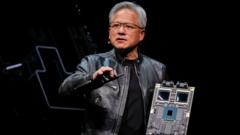The arrival of the Moon dust samples in the UK marks a historic moment, as scientists prepare to delve into new research that could reshape our understanding of the Moon's formation and early planetary dynamics.
Moon Dust Delivered to UK: A Scientific Treasure from China's Chang'e 5 Mission

Moon Dust Delivered to UK: A Scientific Treasure from China's Chang'e 5 Mission
The UK's first lunar rock samples in nearly half a century have arrived from China, promising groundbreaking research opportunities.
The first samples of lunar dust brought back to Earth in nearly 50 years have arrived in the UK, courtesy of China's Chang'e 5 mission. The tiny particles, described by Professor Mahesh Anand as "more precious than gold dust," are currently housed in a secure facility in Milton Keynes. As the sole UK scientist granted access to these rare samples, Prof Anand describes the opportunity as both a significant honor and a responsibility.
Collected during China's 2020 mission, these lunar rocks were unearthed from the volcanic region of Mons Rümker, making this the first successful lunar gathering since the Soviet efforts in 1976. The samples hold the key to unlocking mysteries regarding the Moon's origin, particularly the compelling theory that it formed from debris after a collision between Earth and a Mars-sized planet over 4.5 billion years ago.
In a departure from the traditional isolation of lunar receives, China has opened its doors to international collaboration, presenting samples to seven global researchers, including Prof Anand, who received them in a ceremonious event in Beijing. The level of investment China has made in their space program has placed them at the forefront of lunar exploration, according to Anand, who transported the specimens back in his hand luggage — a testament to their value.
Inside a specialized lab at the Open University, strict precautions are in place to maintain the pristine condition of the Moon dust. Researchers don gown, gloves, and hairnets, and even adhere to sticky mats to prevent contamination. Prof Anand emphasizes that even a microscopic mix of Earthly materials with lunar dust could compromise their work.
Sealed inside ziplock bags, the samples might appear modest, with around 60mg in total, yet understanding their potential is astounding. With expertise in micro-scale geochemistry, Anand's team is poised for discoveries that could span several years.
Kay Knight, a seasoned technician, is eager yet apprehensive about handling the lunar dust. This represents a pinnacle of career achievement, but the fragile nature of the samples adds considerable pressure. The dust will undergo extensive analysis, employing sophisticated machinery meticulously built over decades.
Sasha Verchovsky has assembled a specialized machine to heat samples and extract essential elements, while technician James Malley will deploy lasers to analyze their composition. The goal is ambitious; they have one year to analyze the samples, a process that will inevitably result in the destruction of some material in the quest for knowledge.
Beyond the Chang'e 5 mission, China is progressing as it prepares for Chang'e 6, which aims to fetch samples from the Moon's elusive far side. Prof Anand hopes this collaboration will catalyze future partnerships among international scientists, fostering a spirit of shared discovery reminiscent of the Apollo missions, and ultimately paving the way for new explorations and ownership discussions concerning lunar resources.
















